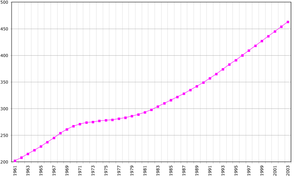Demographics of Cape Verde
2007 Schools Wikipedia Selection. Related subjects: African Geography
The Cape Verde archipelago was uninhabited until the Portuguese discovered it in 1456. African slaves were brought to the islands to work on Portuguese plantations. As a result, Cape Verdeans are mestiços, who have mixed African and European origins. Mestiços’ European ancestors also include Spanish and Italian seamen who were granted land by Portuguese Empire and followed by Portuguese settlers and exiles and Portuguese Jews who were victims of Inquisition. The remainder includes mostly pure blacks and pure whites (most Portuguese stepped out of the country after independence). Many foreigners from other parts of the world settled Cape Verde as their permanent country. Most of them were Dutch, French, British ( English), Arab and Jewish (from Lebanon and Morocco), Chinese (especially from Macau), American, and Brazilian (including people of Portuguese and African descent) settlers. All of these have been absorbed into the mestiço population. Vestiges of African culture are most pronounced on the island of Santiago, where 50% of the people live. Survival in a country with few natural resources historically has induced Cape Verdeans to emigrate. In fact, of the more than 1 million people of Cape Verdean ancestry in the world, only a little more than one-third actually live on the islands. Some 500,000 people of Cape Verdean ancestry live in the United States, mainly in New England. Portugal, the Netherlands, Italy, France, and Senegal also have large communities. Cape Verdean populations also settled Spain, Germany, and other CPLP countries (Brazil and Guinea-Bissau).
Although the official language is Portuguese, most Cape Verdeans speak a creole language ( Crioulo, Kriolu, Criol) derived from archaic Portuguese, African, and other European languages. There is a rich repertoire of literature and songs in Crioulo. In religion, most of them follow a blend of Roman Catholic Christianity and African ethnic faiths.
Demographic data from the CIA World Factbook
Population
- 420,979 (July 2006 est.)
Age structure
- 0-14 years: 37.9% (male 80,594/female 79,126)
- 15-64 years: 55.3% (male 113,450/female 119,423)
- 65 years and over: 6.7% (male 10,542/female 17,844) (2006 est.)
- 15-64 years: 55.3% (male 113,450/female 119,423)
Population growth rate
- 0.64% (2006 est.)
Birth rate
- 24.87 births/1,000 population (2006 est.)
Death rate
- 6.55 deaths/1,000 population (2006 est.)
Net migration rate
- -11.91 migrant(s)/1,000 population (2006 est.)
Sex ratio
- At birth: 1.03 male(s)/female
- Under 15 years: 1.02 male(s)/female
- 15-64 years: 0.95 male(s)/female
- 65 years and over: 0.59 male(s)/female
- Total population: 0.95 male(s)/female (2006 est.)
- Under 15 years: 1.02 male(s)/female
Infant mortality rate
- Total: 46.52 deaths/1,000 live births
- Male: 51.63 deaths/1,000 live births
- Female: 41.26 deaths/1,000 live births (2006 est.)
- Male: 51.63 deaths/1,000 live births
Life expectancy at birth
- Total population: 70.73 years
- Male: 67.41 years
- Female: 74.15 years (2006 est.)
- Male: 67.41 years
Total fertility rate
- 3.38 children born/woman (2006 est.)
HIV/AIDS
- Adult prevalence rate: 0.035% (2001 est.)
- People living with HIV/AIDS: 775 (2001)
- Deaths: 225 (as of 2001)
- People living with HIV/AIDS: 775 (2001)
Nationality
- Noun: Cape Verdean(s)
- Adjective: Cape Verdean
Ethnic groups
- Creole (mulatto) 71%, African 28%, European 1%
Religions
- Roman Catholic (infused with indigenous beliefs); Protestant (mostly Church of the Nazarene)
Languages
- Portuguese, Crioulo (a blend of Portuguese and West African words)
Literacy
- Definition: age 15 and over can read and write
- Total population: 76.6%
- Male: 85.8%
- Female: 69.2% (2003 est.)
- Total population: 76.6%
